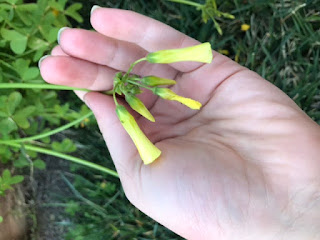Windowsill Dye Studio
Alternatively, call this blog entry The Frugal Dyer. I’m doing natural dye things this week, inspired by the huge amount of oxalis pes-caprae in my yard. I thought I’d share how to dye with plants without using more than some hot water, possibly a strainer, and a few glass jars to process them.
This is O. Pes-caprae. It’s really common in my part of North America, and it’s an invasive weed here so I don’t see a problem with picking some to dye with. Check your local regulations on picking things, though. You can use any plants with high tannin contents or that are acidic; they shouldn’t need mordants but do your own research. I like onion skins, oxalis, or avocado pits.
Find some yarn, fiber, or fabric. Wool is best, but cotton or linen might work. You really don’t want to use synthetics because they won’t take the dye well.
You’re also going to need access to hot water (boiling helps but it’s not necessary), a glass jar or two, a couple small rocks, and some way to filter the dyestuff out after it’s steeped. The process is somewhat similar to making solar tea, but remember that anything used for dye can not be used for food. Ever. Even natural dyes are not safe enough to be in the same containers as food, especially not if you use mordants.
Put the flowers (with oxalis you just need the flowers to get a nice yellow) in a glass jar, and fill the jar with hot water just until they’re covered completely. Drop in the rocks (make sure they’re clean!), and close the jar. Next, shake the jar until the rocks start to bruise the flowers. Technically using rocks isn’t necessary (the shaking is enough) but it makes the process go faster.
Leave it on a windowsill, in the sun if possible, and shake it occasionally. When the water turns the color you want (anywhere from a few hours to a couple days depending on intensity), pour the dye through a strainer into another jar or a bowl to remove all the plant matter. Alternatively, if you lack a strainer or another jar, pick it out with a spoon or something. It doesn’t need to be perfect but you want to get as much as you can out.
At this point, you have dye. You should get it into a closed container, probably the same jar again, and then you can add the textiles you’re dyeing. Leave them in the jar until they’re a nice color, remembering that dye lightens when it dries. When you pull them out, rinse them until the water runs clear and let them dry completely. You can probably use a decently concentrated amount of oxalis dye more than once — it’s pretty strong. Other colors aren’t always as strong but the general rule of thumb is that dye is good until it’s exhausted (when the water is clear).
I’ve got a nice setup for dyeing, and it all fits on a windowsill. I hope this inspires people to try some dyeing themselves!





Comments